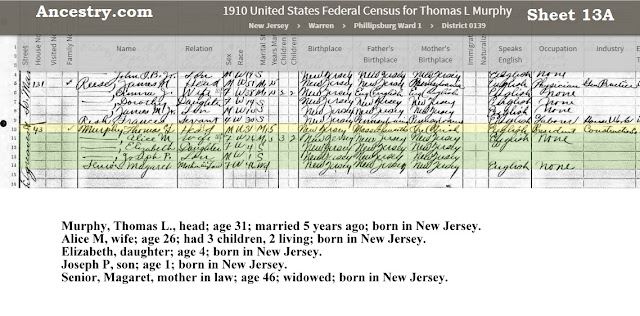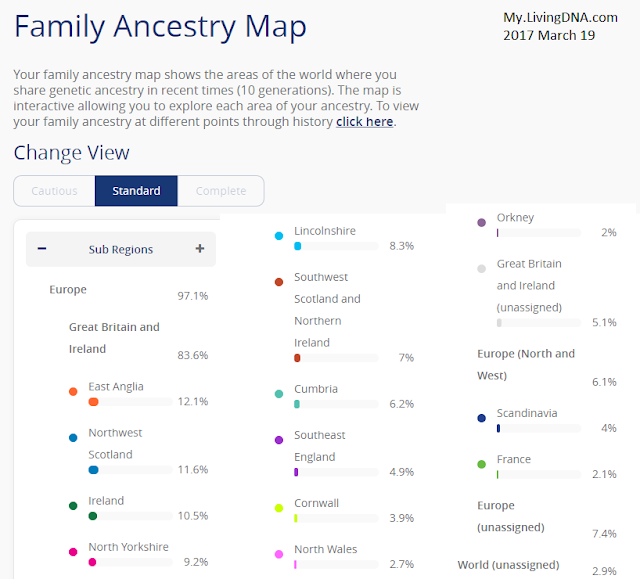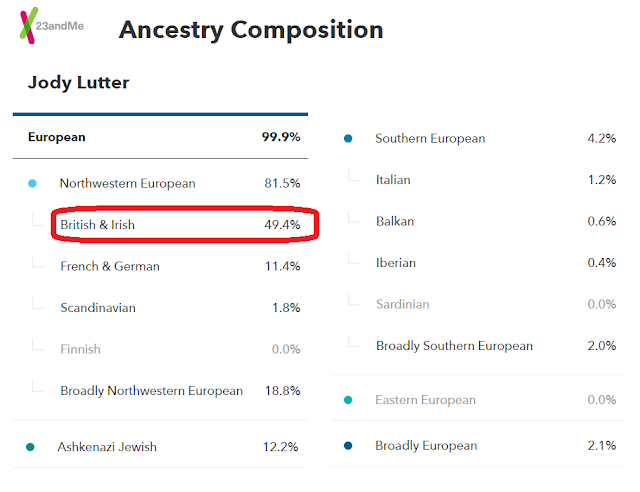Genetic Communities is Ancestry.com's newest feature for DNA testers.
This is not the same as an ethnicity estimate. Please see The DNA Geek's more elaborate explanation and discussion of Genetic Communities.
Ancestry.com's DNA test estimates my ethnicity as 56% Irish with no further breakdown. [Living DNA provided a regional breakdown within England, but not Ireland.]
The Genetic Communities tool detects a heavy link among my DNA matches to people with roots in northern Ireland, or Ulster Irish. The Irish is from my mother's side. I have not determined a place of origin for most of her ancestors, but her great grandfather, Patrick Francis ODonnell (1856-1931) was from County Donegal, which is part of the region encompassed by Ulster on Ancestry's map.
The other Genetic Community was a pleasant surprise because we are out of Europe and exactly where most of my father's ancestors were in the 1700s: New York and New Jersey. Early Settlers of New York tended to hail from certain areas of Europe, which is reflected in my father's ethnicity estimates. Until the Genetic Community tool, there was no DNA-based connection to New York.
When trying to find the most recent common ancestor of a DNA match, you need a geographic connection. In the match's family tree, the focus falls on branches who lived in the the New York area. This New York Genetic Community provides support for this approach.
Growing family trees from leaves and branches. Finding lost relatives. Solving family mysteries. Concentrating in New Jersey and New York.
Pages
- Home
- Surnames and Locations of My GGG Grandparents
- DURYEA New Jersey Births
- DURYEA New Jersey Marriages
- DURYEA New Jersey Deaths
- DURYEA New York State Marriage Index
- DURYEA New York State Death Index 1881-1950
- Pictures by Clifford Lutter 1930s-1960s New Jersey
- ODonnell- New Jersey Records
- Hit or Miss Records
- DNA Comparisons
- Genealogy Humor
- Bayonne Neighbors
Tuesday, March 28, 2017
Sunday, March 26, 2017
Marriage Record from Estate Sale
This is a wonderful estate sale find.
It is a marriage record dated August 9, 1905 from Saint Joseph's Church in Washington, Warren County, New Jersey for Thomas Lawrence Murphy and Alice Margaret Senior.
(Note: There are several places in New Jersey named "Washington." Be mindful when searching for a location bearing this name.)
This family heirloom was behind a painting and was discovered when the painting was brought in for re-framing. The marriage record was placed in its own glass frame and is so firmly situated that I did not free it for the photographs, hence the reflections in these images.
The writing is fading, but readable. Seals from the church are still raised.
The officiant was Reverend Joseph A Rigney. According to the website of Saint Joseph's Parish, Father James Rigney served in the years 1898-1906.
Witnesses were John P Brennan and Elizabeth C Senior.
In the 1910 federal census, Thomas and Alice are living in Phillipsburg, Warren County, New Jersey with two children, Elizabeth, age 4, and Joseph, age 1. They are enumerated twice, once with Alice's mother, Margaret, and once without her. Note that one entry lists Thomas' father's place of birth as Massachusetts, while the other lists Ireland.
Find A Grave has entries for the burials of Thomas (died 1945), Alice (died 1953), and their daughter, Elizabeth Ward (died 1988), in Saint Joseph's Catholic Cemetery in Washington.
If someone from the Murphy and/or Senior families would like this document, please let me know.
Thursday, March 23, 2017
Living DNA Results
The results of my Living DNA test have arrived.
The screenshots are shared with you below, along with comparisons to other DNA companies.
Living DNA places my ancestry as more British than I was expecting. My mother is about three quarters Irish, yet this test puts me at about ten percent.
Part of the attraction of Living DNA's test is breaking down where in Great Britain one's ancestry may have originated. To be fair, I have not traced most of my ancestral lines to precise locations in Europe.
Above is my father's tree with flags representing discovered places of origin. Except for the short Lutter/Uhl branches, in the 1600s most of his ancestors left Europe for land that would become the United States. The port of sailing is not necessarily where they were born and raised, so assigning a country of origin is tricky.
The three main DNA testing companies in the United States also provide ancestry estimates.
Family Tree DNA estimates my ancestry to be about 87% British Isles, which is most similar to Living DNA.
Ancestry.com estimates me to be more than half Irish and only thirteen percent British.
23andMe paints me at almost half British and Irish.
Living DNA estimates the locations of your ancestors throughout time. The map above shows where my ancestors may have been about 500 years ago, when most people were stuck within a few miles of where they were born because travel was difficult and ocean-worthy ships were not yet developed.
The map above shows where my ancestors may have lived 1200 years ago, before written records to trace this genealogy.
Jumping back 5500 years ago, my ancestors could have been in all over Europe. It's anyone's guess, but this is Living DNA's try.
In a similar vein, a new feature at 23andMe estimates when your most recent ancestor from a specific population entered your DNA. Maybe 1950 is my mother's Irish, 1920 is her Ashkenazi grandparent, 1890 is my father's German paternal grandfather, and the rest is the mixture that I am.
The screenshots are shared with you below, along with comparisons to other DNA companies.
Living DNA places my ancestry as more British than I was expecting. My mother is about three quarters Irish, yet this test puts me at about ten percent.
Part of the attraction of Living DNA's test is breaking down where in Great Britain one's ancestry may have originated. To be fair, I have not traced most of my ancestral lines to precise locations in Europe.
 |
| B F Lyon visualizations |
The three main DNA testing companies in the United States also provide ancestry estimates.
Family Tree DNA estimates my ancestry to be about 87% British Isles, which is most similar to Living DNA.
Ancestry.com estimates me to be more than half Irish and only thirteen percent British.
23andMe paints me at almost half British and Irish.
Living DNA estimates the locations of your ancestors throughout time. The map above shows where my ancestors may have been about 500 years ago, when most people were stuck within a few miles of where they were born because travel was difficult and ocean-worthy ships were not yet developed.
The map above shows where my ancestors may have lived 1200 years ago, before written records to trace this genealogy.
Jumping back 5500 years ago, my ancestors could have been in all over Europe. It's anyone's guess, but this is Living DNA's try.
In a similar vein, a new feature at 23andMe estimates when your most recent ancestor from a specific population entered your DNA. Maybe 1950 is my mother's Irish, 1920 is her Ashkenazi grandparent, 1890 is my father's German paternal grandfather, and the rest is the mixture that I am.
I hope that Living DNA offers the matching with cousins feature of the other three DNA companies. Because it is based in the United Kingdom, Living DNA may attract consumers who will not test with one of the companies marketed primarily in the United States and expose me to new DNA cousins.
Subscribe to:
Posts (Atom)














